PinotFile: 8.5 November 13, 2009
|
Cruzin’ the Santa Cruz MountainsI returned yesterday from a week long sojourn in the Santa Cruz Mountains. David and Wendy Lloyd, noted Australian vintners of Pinot Noir (Eldredge Estate in the Mornington Peninsula), wanted to explore the region so I took them an a journey to many of the top wineries in the area. It is not easy to get your arms around the region, for it spreads over 380,000 acres in three counties: Santa Cruz County to the West, Santa Clara County to the East, and San Mateo County to the North. It takes nearly two hours to drive from the northern end at Half Moon Bay to the southern end at Mount Madonna north of Gilroy. The wineries are often tucked into nooks and crannies in the mountainous terrain, hidden from view by towering redwood trees, and often at the end of one lane and circuitous roads. The map provided by the Santa Cruz Mountains Winegrowers Association does not show specific locations of the wineries. County regulations prohibiting signage to the wineries, GPS systems are unreliable in many areas, and cell phones can be worthless. The resulting challenges involved in navigating to wineries are offset by the beautiful landscape and lack of traffic. The Santa Cruz Mountains is one of the few remaining wine regions where you will never see a limousine and tasting room staffs are appreciative of your efforts to seek them out. The Santa Cruz Mountains American Viticultural Appellation (AVA) was federally approved in 1981 and was one of the first AVAs to be defined by geophysical, altitudinal and climatic factors. The east and west boundaries are defined by elevation, including mountainous land above 400 feet on the western side, and from 400 to 800 feet on the eastern side. The squiggly outline of the Santa Cruz Mountains AVA reflects the fog line that surrounds the mountains (see map page 2). Winegrowing in the Santa Cruz Mountains goes back to at least the 1860s when George Jarvis planted vines in the Vine Hill area of Santa Cruz County. By the late 1880s, the region had 38, most small wineries. There were 1,600 planted acres by 1905, with vineyards concentrated in the Felton, Bonny Doon, Vine Hill, Ben Lomond and Boulder Creek areas on the western side of the Santa Cruz Mountains. Phylloxera did not find its way easily into the Santa Cruz Mountains, and most of the vines were healthy until Prohibition. After Repeal, the Italians opened several small wineries, and one, Bargetto, is still in production and is Santa Cruz’s oldest. On the eastern side of the Santa Cruz Mountains, Charles LeFranc pioneered commercial winegrowing. He planted his New Almaden Vineyards in 1858. Leland Stanford was a noted winegrower as well, with 350 acres near Mission San Jose and later 158 acres in the Menlo Park area of San Mateo County. Agoston Haraszthy planted vineyards between 1853 and 1856 at Crystal Springs Reservoir in San Mateo County. In 1878, Paul Masson came to San Jose from the Burgundy area of France. He developed a vineyard with cuttings from his friend, Burgundian Louis Latour, and started a winery in the Santa Cruz Mountains adjacent Mount Eden. Martin Ray became a protege of Paul Masson and just after Repeal purchased the Paul Masson Champagne Company from Masson. In 1942, Ray sold the Paul Masson property and moved up the hill, planting the first vineyard at Mount Eden to Pinot Noir and Chardonnay (Cabernet was added in the 1950s). He named his estate “Martin Ray,” and became the first boutique Pinot Noir winery and the first to produce a 100% Pinot Noir varietal wine in California making the Santa Cruz Mountains the birthplace of Pinot Noir in North America. Martin Ray’s years on Mount Eden are recorded in a book written by his widow, titled, Vineyards in the Sky. Ray eventually sold Mount Eden to a group of investors who launched the Mount Eden brand in 1972. Today, Mount Eden is owned by winemaker Jeffrey Patterson who has been at the winery since 1981. Another iconic figure in the Santa Cruz Mountains was David Bruce, M.D.. According to interviews conducted by Carole Hicke in 2001 (The David Bruce Winery: Experimentation, Dedication, and Success), Bruce was attending Stanford Medical School when he had his wine epiphany: a bottle of Richebourg that cost him $7.50. He planted his vineyard in the Santa Cruz Mountains in 1961 and the David Bruce Winery became bonded
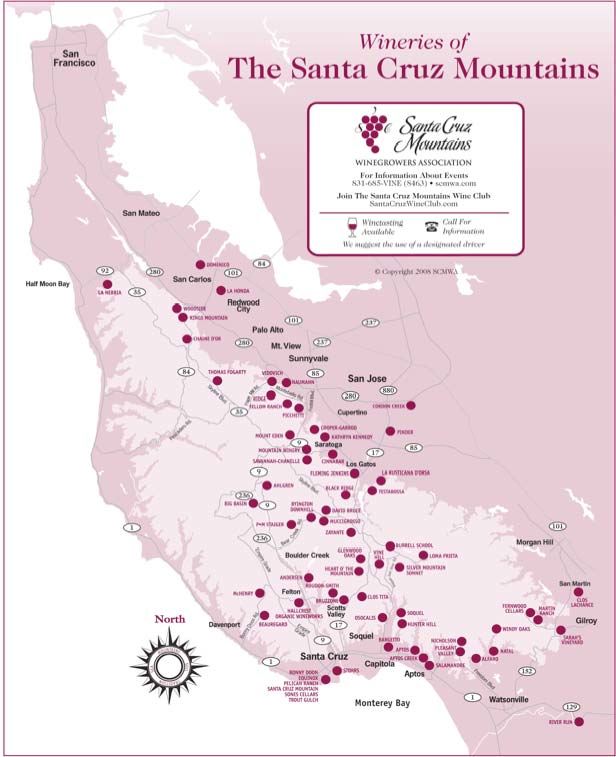
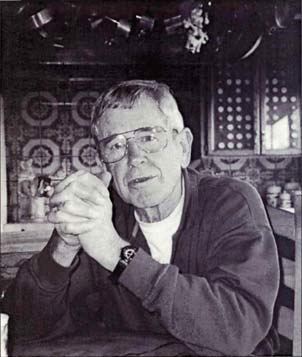 in 1964. For twenty-five years he practiced dermatology and made wine simultaneously. He was one of twelve California wineries to participate in the 1976 Judgment of Paris in which California wines outscored the French in blind tastings. Bruce was an innovator with many firsts attributed to him including a California Blanc de Noir, a white wine from Zinfandel grapes, late harvest wines, malolactic fermentation for white wines, and use of whole berry fermentation for red wines. He was also an early importer of French oak. Bruce was a proponent of punch downs by foot, extensive skin contact, and small French oak barrel fermentation. Bruce made his first commercial Pinot Noir in 1966. His early trials with Pinot Noir were marked by hits and misses, with Brettanomyces causing problems in a number of his early wines. Eventually, he overcome his shortcomings and produced Pinot Noirs that brought considerable acclaim. Today, over 800 acres are planted to Pinot Noir in the appellation, most of which are 1 to 20-acre plantings on moderately steep hillsides on the western mountain ridges above Monterey Bay and the fog line. Beauregard Vineyards, the largest grower, manages about 60 acres of Pinot Noir. Located at elevations of 400 to 2,600 feet, most vineyards are exposed to warm days, cool nights, coastal fog in the mornings, and soft marine breezes in the afternoons. There are about 90 wineries in the Santa Cruz Mountain AVA, over half of which produce Pinot Noir. Because of the limited vineyard acreage, many Santa Cruz Mountains wineries source grapes from outside the appellation. However, it is the Santa Cruz Mountain fruit that is most prized and that produces the distinctive mountain-grown Pinot Noirs that have made the region famous.
The soils are varied throughout the appellation, and include decomposed rock, clay, loam and limestone. The
overriding effect in most areas is a fresh, mineral character and an inviting acidity in the wines. Although the
soil type is not uniform, the ocean fog influence is consistent and ties the appellation together. The Pinot Noir
vineyards in the Santa Cruz Mountains have been grouped into six sub-regions through extensive tastings
conducted by Appellation America and the efforts of Mary Lindsay, President of the Viticulture Association of
the Santa Cruz Mountains, and Prudy Foxx, a well-known viticulturist in the Santa Cruz Mountains who
consults on and manages many vineyards in the region (refer to map on page 4 for the proposed sub-regions).
The subregions include Skyline, Summit Road, Coastal Foothills, Ben Lomond Mountain, Saratoga/Los Gatos,
and Corralitos/Pleasant Valley. Each of the sub-regions have different climatic influences and the wines seem
to have distinctive aromatic and flavor profiles. Listen to this year’s Pinot Paradise Technical Seminar which
includes introductory remarks on the Santa Cruz Mountains by Jim Schultze of Windy Oaks Vineyards &
Winery, a talk on the contrasts between Burgundy and the Santa Cruz Mountains by Joe Miller, PhD, University
of California at Santa Cruz, and a discussion of the newly identified subregions of the Santa Cruz Mountains by
Clark Smith, Director of Appellation Tastings at Appellation America: “Pinot Paradise 3-27-09” The quality of the Pinot Noir grapes grown in the Santa Cruz Mountains appellation is unquestioned, but the challenges in growing wine in this harsh mountainous terrain are numerous. Historically, grapes ripened in only three out of every ten vintages and the wines were often described as rustic, chunky and tannic. Irrigation water is very limited or nonexistent, birds (all vineyards must be netted), deer (all vineyards must be fenced) and gophers are every-present, top soil is poor in many sites, skilled labor is hard to find, and disease pressure, particularly downy mildew, powdery mildew and botrytis is ever-present. Modern viticultural practices including control of mildew, proper trellising, and canopy management have been instituted in the last several years by very experienced vineyard consultants including Prudy Foxx and Greg Stokes. The result has been a noticeable trend toward dependable yields, although still small, and increasing quality of grapes, resulting in wines that consistently exemplify the unique terroir of the region. A small and determined cadre of winegrowers and winemakers have developed a modern style of Pinot Noir from the Santa Cruz Mountains offering lovely aromatics, luscious red and dark fruit flavors, easily approachable tannins, lively acidity, all packaged in a medium-bodied style so juicy you can “nibble” at them. The region still has its eccentric and Bohemian folks who favor the other crop you can smoke rather than the one you can drink and disdain visitors, but the wine populace is more than welcoming. In the pages to follow, I will give you a run down on the wineries I visited and the wines I tasted. In addition, I tasted several Santa Cruz Mountains Pinot Noirs at home in my usual setting.
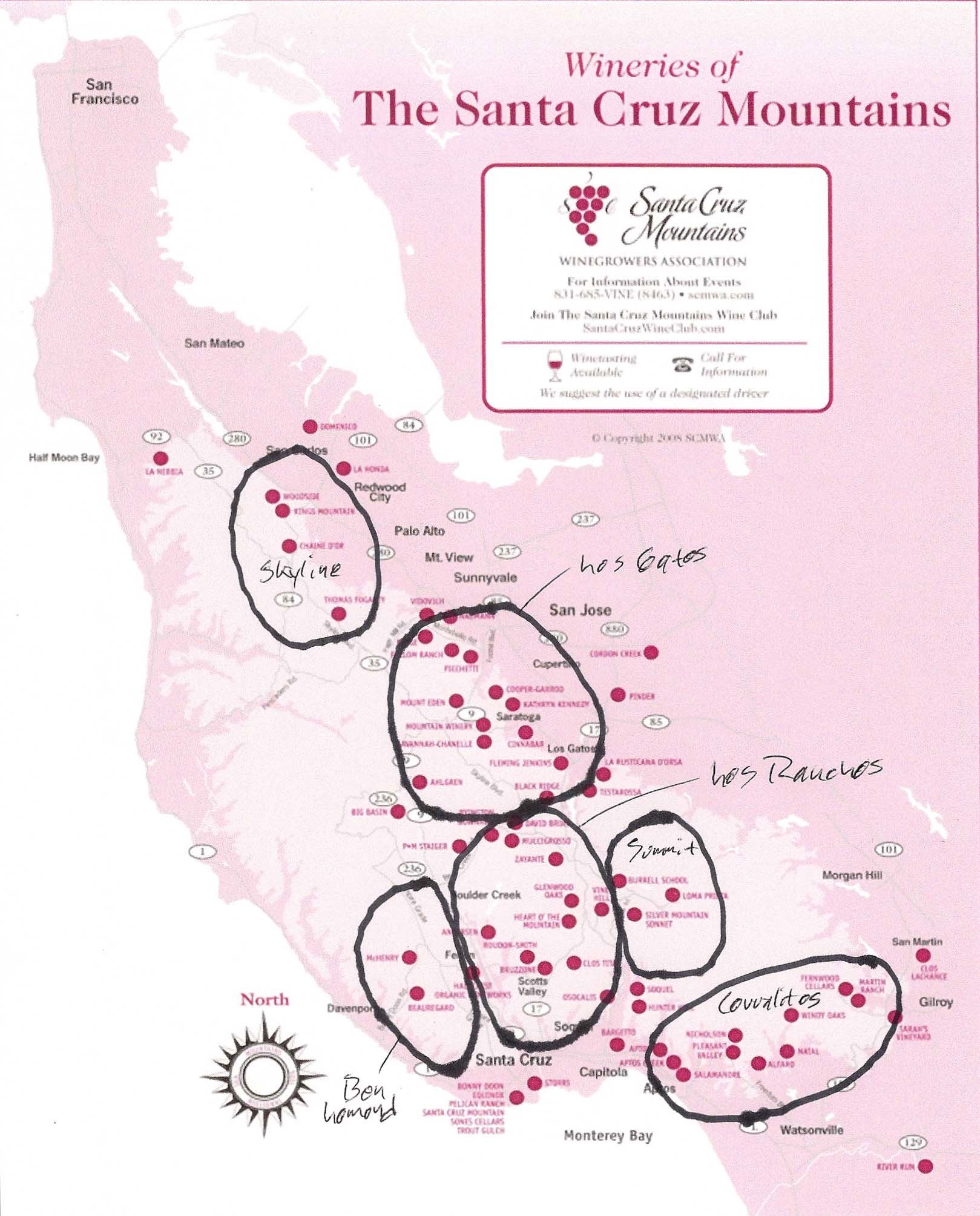
Varner WinesI had never had the opportunity to visit this winery although I had admired the wines for several years. Varner is a partnership between twin brothers, Bob and Jim Varner. Their winery has been quietly making a name for itself for its Chardonnays under the Varner Estate label and the secondary label, Foxglove. The Pinot Noirs, released under the Varner and Neely labels, are less well known but worth your interest as well. Because access to the estate vineyard and winery are through the Russian Ridge Open Space Preserve in the Santa Cruz Mountains, the winery cannot have a tasting room or conduct events and thus has largely been hidden from the public eye. Jim Varner was kind to host our small group at the winery which sits among scenic grassland hills in Portola Valley. As we tasted through barrel samples of the 2009 Chardonnays and several finished Pinot Noirs, Jim told us the story behind Varner Wines. Jim Varner is a graduate of University of California at Davis and began his winemaking career in the Napa Valley. He longed for a cooler climatic region and found the current site of Varner Wines in the Skyline sub-region of the Santa Cruz Mountains (on the map on the previous page, Varner is not depicted but sits just west of Palo Alto, 12 miles east of the Pacific Ocean and 10 miles west of the San Francisco Bay). The property is situated within a large parcel that is owned by Dr. Kirk Neely and his wife Holly. Jim’s brother, Bob, was studying genetics at the University of California at Berkeley when his brother invited him to see the property. He was immediately taken by the site and the two began planting the estate Spring Ridge Vineyard in 1980. They started with Chardonnay and Gewürztraminer planted on their own rootstocks. Over the ensuing years, further blocks were added with cuttings taken from the original vineyard. In 1997, 7 acres of Pinot Noir were planted (clones 115 and 777), and in 2006, the Gewürztraminer was grafted over to Pinot Noir clone 777, effectively resulting in 25-year-old vines. Bob eventually became the winemaker and Jim took over the sales and marketing of Varner Wines.
 The Spring Ridge Vineyard is farmed organically with no pesticides other than sulfur to control mildew. Other disease pressure is controlled by canopy management. Several distinct blocks have been identified within the vineyard. For the Chardonnay, there is the Home Block, the Amphitheater Block and the Bee Block. The Varners harvest, vinify and bottle the various Chardonnay blocks separately, but vinification methods are the same. This magnifies the subtle differences between the microclimates and the three wines show distinct differences. The Varners have also produced a Neely “Holly’s Cuvee” Chardonnay that is a blend of the three blocks and is named in honor of Holly Neely. A block-designated Varner Hidden Block Pinot Noir (clone 115) is the signature bottling from the estate. Both a Varner and Neely Pinot Noir are produced from the Picnic Block (clone 777). A Pinot Noir blend, “Holly’s Cuvee,” is also released under the Neely label. The Varner and Neely Pinot Noirs are crafted in nearly the same manner. Very little (2% to 3%) whole cluster is used, fermentations are indigenous, aging is carried out in 24% to 30% new French oak barrels from several cooperages, and the wines are bottled unfined and unfiltered. All winemaking is by gravity flow with no watering back and no acidification. One interesting note is that all the barrels have taps near the bottom to drain the wine instead of pumping it out through the bung. A special metal contraption made in France allows for tipping of the barrels (see photo). In all my years of travels to wineries, I have never seen oak barrels tapped like this.
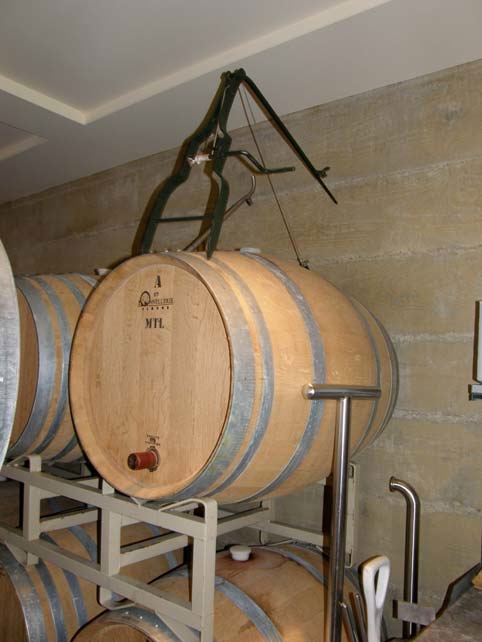
2007 Varner Hidden Block Spring Ridge Vineyard Santa Cruz Mountains Pinot Noir 14.6% alc., 400 cases, $39. The current release. · A savory wine marked by attractive aromas of roses and spice with a delicate touch of oak. The dark stone fruit is well presented with fine, dry tannins and perfect balancing acidity. A thoroughly enjoyable wine. Very good.
2005 Neely Holly’s Cuvee Spring Ridge Vineyard Santa Cruz Mountains Pinot Noir 14.2% alc., $39. 55% 115, 45% 777. · More herbal and not as savory as the Varner Pinot Noirs. Cherry fruit dominates with a green and oaky edge. Decent.
 2005 Neely Picnic Block Spring Ridge Vineyard Santa Cruz Mountains Pinot Noir 14.2% alc., $39. Clone 777. · Amazing aroma of fresh crushed black cherries. Notably earthy and tannic with an underpinning of charcoal and tar. The fruit is full-bodied and forward with a thick texture. Decent.
 2004 Varner Hidden Block Spring Ridge Vineyard Santa Cruz Mountains Pinot Noir 14.2% alc, $39. · A highly nuanced wine showing aromas of ripe fruit, roses, oak, tobacco and earth. With time in the glass, the medium-weighted flavors of dark Pinot fruits blossom with supporting hints of spice, edible flowers and herbs. Drinking perfectly now with supple tannins and an appealing softness and roundness. Very good.
Varner wines are sold primarily through a mailing list, on the website (www.varnerwine.com), and through limited retail distribution. The winery is not open to the public. Don’t forget the Chardonnays, they are in the top echelon of California and walk the line between full-blown buttery Chardonnay styles and more austere stainless steel fermented types of Chardonnays. A second label, Spring Ridge, is an outlet for estate fruit that doesn't make the cut for the Varner label. In 2006, all of the estate Pinot Noir was declassified and the Varners did not produce a Varner Pinot Noir. 100% of the Hidden Block fruit went into the 2006 Spring Ridge Pinot Noir. At $19.99, it is a real bargain. 650-321-4894.
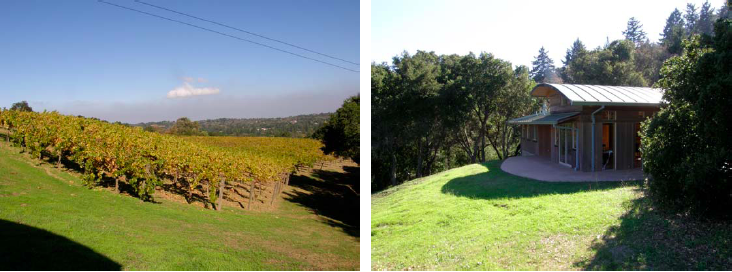
Rhys VineyardsI wrote extensively about this innovative winery after my previous visit earlier this year (PinotFile, Volume 7, Issue 13). The five Rhys estate Santa Cruz Mountain vineyards are scattered throughout the Skyline subregion within a 25-minute drive of each other. Each vineyard has a distinctly different soil and geology and presents special challenges to successful winegrowing. Proprietor Kevin Harvey is quick to admit that it has taken time to learn the vagaries of each vineyard’s microclimate and topography, and the most appropriate clonal selections for each site. The Alpine Road Vineyard, pictured below, is very steep requiring hand farming and measures to control erosion. Yields have been painfully low, and the cost of developing this vineyard has exceeded all expectations. Harvey is a bright and determined sort and he obviously enjoys the challenges. His first wines have made a big impression on the wine community, and this has fueled his determination.
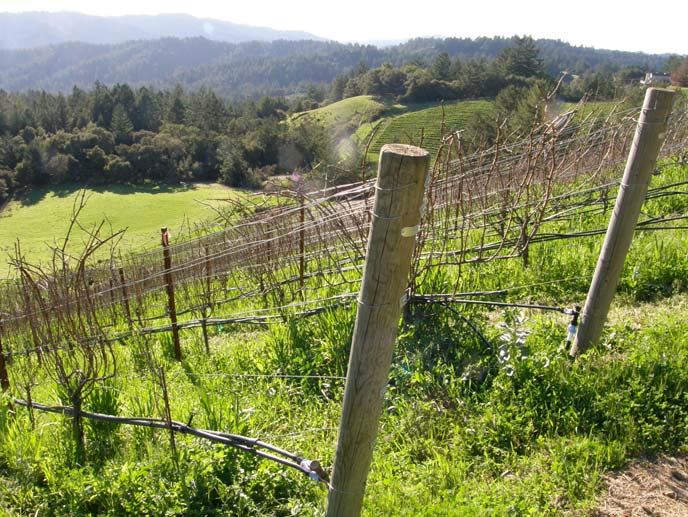 The model at Rhys is clearly Burgundy and more specifically domains such as DRC and Dujac. Several of the vineyards are planted to close spacing using a multitude of Dijon and California heritage clones duplicating the clonal diversity or selection massale approach in Burgundy. 100% whole cluster fermentation is the rule, making these wines less appealing upon release than they become upon aging, much like their Burgundy brethren. There is no compromise in vinification that would lead to early and flashy consumer-friendly drinkability. That said, the 2007 vintage Pinot Noirs are extremely appealing now, but will definitely reward more time in the cellar. Winemaker Jeff Brinkman (pictured below) is reserved and unassuming, but when you engage him to talk about his winemaking goals, his insight and talent is evident.
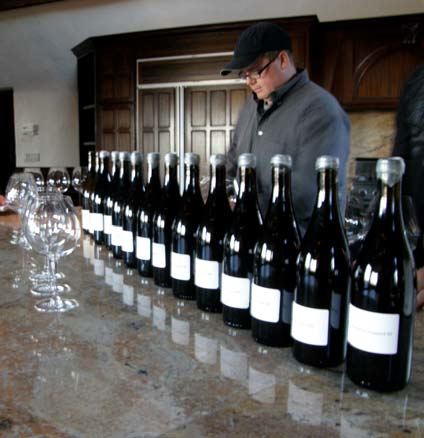 Rhys Vineyards is developing a new vineyard in Anderson Valley named Bearwallow, named after the Bearwallow-Wolfey series of soil that dominates the property. This vineyard has 7 acres of 9-year-old vines that are in production and have been farmed organically. The first vintage from this 20-acre site is 2008 and is vinified using grapes from these existing vines. The vineyard, which is in the far deep end of the Anderson Valley, will need several years of refurbishing and updating to reach its ultimate potential. This vineyard meets all the criteria that Harvey considers critical for producing great Pinot Noir: shallow soils, deeply fractured and rocky subsoil, steep non-forested slopes, iron-rich soils (a key to minerality in Pinot Noir), moderate clay content with limited water holding capacity, and a cool climate. New plantings in this vineyard will be on the steeper slopes that meet all the criteria. Vine densities will be 2300 (tractor farmed) and 7000 (hand farmed) vines per acre. Planting will be with selection massale, a diverse mixture of vines. Most of the vineyard will be devoted to Pinot Noir, but a few blocks will be dedicated to Chardonnay. A new winery on Skyline Drive is nearing completion and will be ready for the 2010 harvest. Built entirely underground, the grapes will enter the cave entrance and the finished wines will exit through another opening in the cave. Expect this to be the showpiece winery in the Santa Cruz Mountains and bring much-needed recognition to this region. A tasting room will be opened in a former home on the property which has magnificent views of the surrounding terrain.
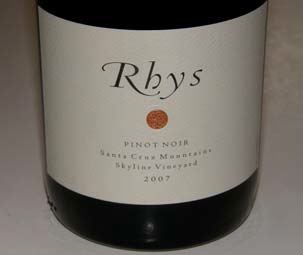 We tasted through barrel samples of the 2008 vintage. Typical for Rhys wines, the alcohols are under 14.0%. The Pinot Noirs are showing generous and appealing aromatics and intense mineral-laden fruit, with substantial tannins at this point. There is a special charisma to the Rhys Pinot Noirs that will appeal to the connoisseur. The Home Vineyard Pinot Noir is a dense wine with deep, dark reddish-purple color, hard tannins, and a lush finish. The Family Farm Vineyard Pinot Noir exhibits the most whole cluster character complementing the earthy dark berry fruit. The Alpine Road Vineyard Pinot Noir is a ringer for a Cote de Nuits wine with its rich black raspberry jam flavor and generous tannic backbone. The Swan selection bottling from this vineyard is the star in the lineup with more nuances and savoriness. Horseshoe Ranch Vineyard is more akin to a Beaune wine with a lovely floral scent and noticeable underlying earthiness and minerality. Skyline Vineyard is rather exotic, flush with well-spiced dark cherries and berries, and showing substantial young tannins. Bearwallow Vineyard Pinot Noir has more approachable dark red Pinot fruits and a crispness that reveals its cool climate origins.
Rhys Vineyards takes its name from Kevin Harvey’s family name, the Welsh spelling of Reese. The very
limited production wines are only sold through a mailing list (www.rhysvineyards.com). Yields were down in
2007, but future vintages should result in more production as the vineyards develop more maturity and new
plantings come on line. Click here to listen to an interview with Kevin Harvey in two parts: “Kevin Harvey Interview Part 1”
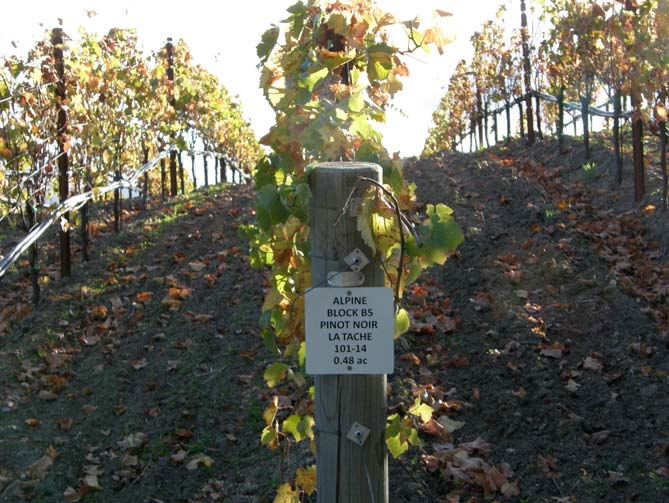
Alfaro Family Vineyards & WineryRichard Alfaro’s winery is barely over ten years old, but he and his wife, Mary Kay, have had a personal interest in wine for well over twenty-five years. Richard is a long time wine collector, a Cabernet Sauvignon and Bordeaux aficionado originally, and Mary Kay is a certified sommelier. Richard’s success as a baker allowed him to pursue his wine passion. He founded Alfaro’s Micro-Bakery in Watsonville in 1988 and was one of the first in California to produce quality speciality breads which have now become commonplace at markets. In 1998 he sold the bakery to Sarah Lee who were eager to acquire his recipes. This gave him the funds to acquire a 75-acre apple farm at the southern tip of the Santa Cruz Mountains appellation in Corralitos. Richard had his Pinot Noir epiphany in 1996 when he drank a 1994 Rex Hill Reserve Willamette Valley Pinot Noir at a restaurant in Lake Tahoe. He was taken by the wine and returned to the same restaurant the next evening to confirm his impressions. He ordered another bottle of the same wine and it was even better the second time around. Today, Alfaro Family Vineyards has one of the largest plantings of Pinot Noir in the Santa Cruz Mountains. Lindsay Paige Vineyard is named after the Alfaros’ daughter. Planted in 1998, the 7-acre vineyard has both Chardonnay and Pinot Noir on a south-facing hillside at elevations between 500 and 650 feet. The high density planting of Pinot Noir (almost 2,000 vines per acre) consists of multiple clones including Dijon 113, 114, 115, 667, 777, and 828, and Pommard 4 and 5. The Alfaro Family Vineyard is the largest vineyard at just over 16 acres and is planted only to Dijon Pinot Noir clones 113, 114, 115, 667, 777, and 828 (1,361 vines per acre). Ryan Spencer Vineyard, named after the Alfaro’s son, was planted in 2001. This vineyard is composed of 7 acres broken into 6 different blocks with Pinot Noir (Pommard 4 and 5), Chardonnay, Merlot, and Syrah planted. Mary Katherine Vineyard is at the summit of the property, between 700 and 850 feet in elevation on a steep terrace. Own-rooted vines were planted in 2008 with cuttings selected from a Grand Cru Vosne- Romanee monopole vineyard. The Robert Young clone of Chardonnay makes up the remainder of the plantings here. This vineyard is named after Richard’s spouse to whom he has been married to for 26 years.
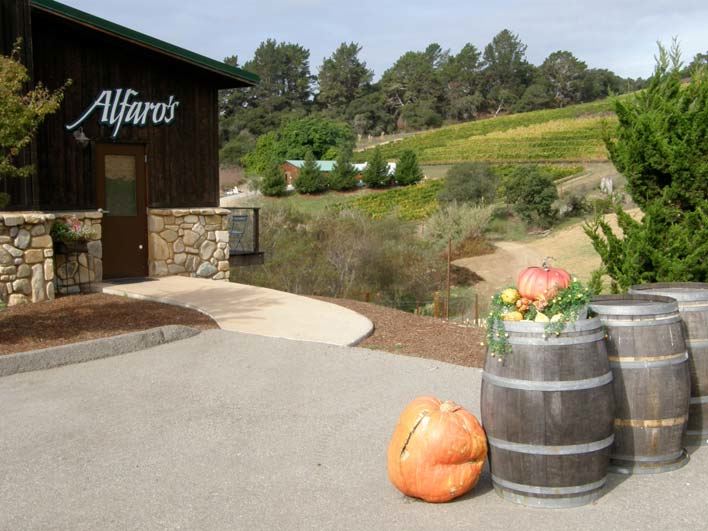 The Alfaro wines are full-bodied, well-endowed and moderately tannic and will appeal to those with a love of rich and luscious Pinot Noirs. They can stand up to hearty food such as short ribs. The wines are improving with each vintage as Richard’s vines become more mature and he becomes more adapt at working with the estate fruit. Alfaro previously had a second label with a winemaker partner (Martin Alfaro Wines), but this line of wines has been discontinued.
2007 Alfaro Family Vineyards & Winery Lindsay Paige Vineyard Santa Cruz Mountains Pinot Noir Bottled a few months ago, unreleased. 10 clones. Aged 20 months in 70% new French oak barrels. · Quite approachable and charming now featuring a crisp core of red cherries and berries with an accent of oak spice. Well-structured with healthy tannins and built for the long haul. Very good.
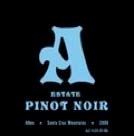 2007 Alfaro Family Vineyards & Winery “A” Estate Santa Cruz Mountains Pinot Noir 14.5% alc., pH 3.73, 807 cases, $25. 80% sourced from the three estate vineyards (yields 1.5 tons per acre). 50% whole berry fermentation. Aged 16 months in 40% new French oak. A popular restaurant by-the-glass wine. Released April 1, 2009. · Appealing nose of darker fruits, particularly spiced plums. Rich and full-bodied with a deft touch of oak. Nicely balanced with modest tannins and bright acidity. Ready to go and a very good wine for the tab.
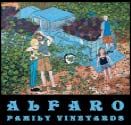 2007 Alfaro Family Vineyards & Winery Estate Santa Cruz Mountains Pinot Noir 14.5% alc., pH 3.59, 256 cases, $35. 100% de-stemmed, 5-day cold soak, whole berry, indigenous fermentation. Aged 15 months in 66% new French oak. Unfined and unfiltered. · A shy but sophisticated nose of hi-tone black cherry and black raspberry fruit with a slight smoky edge. Opens beautifully over time. Tasty, rich black raspberry fruit in a husky style with moderate ripe, dry tannins leading to a lingering and sappy finish. I would cellar this for another year. Very good.
2006 Alfaro Family Vineyards & Winery “A” Scarlet Santa Cruz Mountains Pinot Noir $18. 95% Pinot Noir composed of left over lots. · An easy drinker that is light in weight with tasty cherry fruit and a very dry finish. Decent.
2006 Alfaro Family Vineyards & Winery Lindsey Paige Vineyard Santa Cruz Mountains Pinot Noir 14.2% alc., pH 3.65, 200 cases, $40. Released September 1, 2008. 100% de-stemmed and lightly crushed. 7-day cold soak. Aged 16 months on the lees in 70% new French oak. · Aromas of cherries, vanillin and a hint of oak. Medium-weighted core of cherries and cranberries with a hint of red apple. Juicy and crisp with moderate tannins which could use some more time to soften. Decent (+).
Alfaro Family Vineyards & Winery is open on Saturdays from 12:00 to 5:00 at 420 Hames Road in Corralitos. A new tasting room welcomes visitors to a relaxing deck to picnic outdoors and view the vineyard. You will feel very much at home if Richard or Mary Kay are holding court at the tasting bar to receive you. The wines (including Chardonnay, Merlot and Syrah) are available by phoning 831-728-5172. Visit the website at www.alfarowine.com. Wine club members receive a 20% discount on wine purchases.
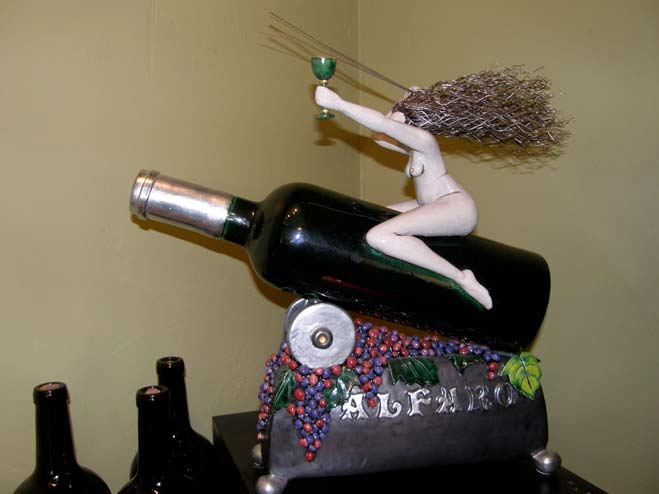
Windy Oaks Estate Vineyards & WineryLike Alfaro, Windy Oaks is located in the tiny hamlet of Corralitos in the southwestern corner of the Santa Cruz Mountains AVA. The proximity of Corralitos to the Pacific Ocean makes it ideal for winegrowing. The summers are dry and warm with foggy mornings and the winters are cool and moist with annual rainfall between 12 and 30 inches. Large temperature swings are not unusual, with 90º days followed by 50º nights. The growing season here is among the longest of any viticultural region in California, with bud break in February and harvest in some vintages extending all the way into the first days of November. Jim and Judy Schultze left the corporate world behind and used their many years of interest and experience in artisan winemaking to create Windy Oaks Estate beginning in 1996. 18 acres are planted to Pinot Noir (including 1 acre of a special Burgundian clone) and 1 acre to Chardonnay at 900 feet on a ridge overlooking the town of Corralitos and the Monterey Bay beyond.
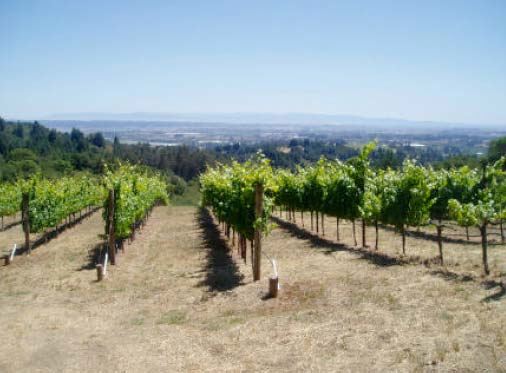 Viticulture and winemaking here is very much Burgundian-themed. The Schultze Family Vineyard is farmed according to sustainable and organic principles with hand-tending of all the vines which are directly monitored for water status. The site is extraordinary for growing the Burgundian varieties, yielding physiologically ripe grapes without high sugars but with high natural acidity. The planted Pinot Noir clones are Dijon 115, 667, 777 and 828, Pommard, and 2A. Winemaking is non-interventional and natural with no additives except yeast (most fermentations are 50% indigenous and 50% inoculated). No racking is done once the wines are in barrel. The Schultzes travel yearly to Burgundy to meet with coopers. They use 3-year-old air-dried tight-grained French oak barrels and age their Pinot Noirs for 18 to 27 months using a relatively high percentage of new oak (50% up to 75%). The wines are neither fined nor filtered. The estate winery is quite modern with a basket press and a bottling line that employs minimal oxygen uptake insuring that the wines go through little or no bottling shock. Jim is experimenting with oak tank fermentation, 100% indigenous yeast fermentation, and 100% whole cluster fermentation. Special limited bottlings of Pinot Noir have been released employing these innovative techniques. The attention to detail throughout the winemaking process and meticulous care of the vineyard have produced extraordinary wines at Windy Oaks.
2018 Windy Oaks Estate Special Burgundy Clone Special Release Santa Cruz Mountains Pinot Noir 13.5% alc., 24 cases, $120. The pinnacle of Windy Oaks wines that comes from the oldest parcel of the singular proprietary Burgundy clone block hand tended by Jim at the home estate vineyard. Jim brought the original cuttings to the United States from a grand cru vineyard in Vosne-Romanée. This wine is made in a single barrel lot with native yeast and partial whole cluster fermented grapes, receiving a long, cool maceration, and native malolactic fermentation, with aging on the lees for 27 months in a special custom French barrique made exclusively for Windy Oaks by artisan coopers in Burgundy. This wine is only released in vintages that are deemed to exemplify its special characteristics. · Light garnet color in the glass. Alluring, even spectacular aromas of Bing cherry, cola and spice.. The essence of black cherry is complimented by a savory tone. Substantial flavor that defies the wine's light color. Impeccably balanced with polished tannins and a lush, distinguished finish that goes on and on. Score: 95
2007 Windy Oaks Estate Cuvée Schultze Family Vineyard Santa Cruz Mountains Pinot Noir 13.9% alc., 360 cases, $38. A blend of clones from the estate vineyard. Aged 16 months in 55% new French oak. · The nose is full of interest with scents of juicy cherries, spice, graham, herbs, oak and a hint of good funkiness. A whiff of alcohol peaks out. Earth-kissed dark red cherry and berry fruit flavors are on the light side but pleasing. Very polished and smooth with supple tannins creating some charming elegance. Decent (+).
2007 Windy Oaks Estate One Acre Santa Cruz Mountains Chardonnay 138 cases, $38. Sampled with lunch at the winery. This proved to be the top Chardonnay tasted during my week in the Santa Cruz Mountains. Barrel aged 18 months in 33% new French oak. · Bright, crisp and fresh with enough white stone and tropical fruit flavor to thoroughly satisfy. Barrel fermentation has contributed complimentary notes of butter, spice and vanillin. A little minerality creeps in on the finish. I have called this wine “a Kistlerkiller” in the past and I am sticking to my claim. Very good.
14.3% alc., $55. Selection of 4 to 6 whole cluster barrels. Aged 21 months in 50% new French oak. · The fruit is darker-toned in this wine and more intense. Scents of plums and berries, oak toast, spice, and a little fecundity lead to a full palate of loamy black cherry and black raspberry fruit with underpinnings of dark chocolate and grilled meat. Perhaps “down and dirty” is a good descriptive. The tannins are fine-grained and dry, the oak is nicely partnered with the fruit, and the wine has the polished sensuality that drives Pinot lovers crazy. Very good.
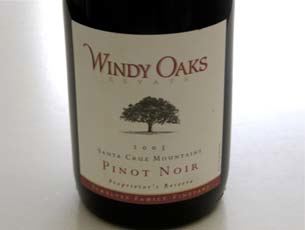 2006 Windy Oaks Estate Proprietor’s Reserve Schultze Family Vineyard Santa Cruz Mountains Pinot Noir 14.1% alc., 345 cases, $60. Primarily sourced from the original 3-acre block of the vineyard. Aged 22 months in 80% new French oak. · The nose is quite refined with attractive cherry and berry aromas with a touch of oak, green herbs and barnyard. On the palate the wine is strikingly soft and smooth, refined and seamless, with discreetly concentrated fruit encased in caressing tannins. Flavors of currants, baking spice and savory herbs add interest. Very good.
14.3% alc., 40 cases, $95. This special half-acre block is tended exclusively by Jim. The clone, a rarely propagated French Pinot Noir clone, is not available in the United States. Aged 27 months in 100% new French oak. I have drank both the 2004 and 2005 versions of this wine and found both to be stunning. I do not have specific tasting notes since I enjoyed the wines with special friends at dinners. I do have fond memories of both wines, however, and can only say they rival the best Burgundies I have ever drank. As good as the other Windy Oaks Pinot Noirs are, this bottling is a step above, a tour de force.
 Windy Oaks Estate wines are sold primarily through the winery’s Wine Group. The Limited Releases such as the Proprietor’s Reserve, Special Burgundian Clone and One-Acre Chardonnay are only available to Wine Group members. Since production is small (2,000 cases of Pinot Noir), the Wine Group has been closed since 2007 (a waiting list is now in place), but an Early Release List allows you to buy most new releases before their offering to the general public. Some wines are sold on the website subject to availability. Visit the website at www.windyoaksestate.com for more information. Special events and open houses are held periodically at the winery for dedicated customers and occasionally the public. 831-786-WINE.
Heart O’ The MountainThis unique property, located in a relatively isolated area of Scotts Valley among the redwoods, is rich with history. Beginning in 1881, Pierre Cornwall produced wine here under the Santa Sada label. Cornwall named his Cornwell Ranch estate “Heart of the Mountain.” The famous director, Alfred Hitchcock, acquired the estate from the Cornwell family in 1940, and lived here on and off until 1970. The property was a hideaway for Hitchcock, a place where he could get away from the public eye and the pressures of Hollywood. Hitchcock built a 5,000 square feet house in a Spanish style surrounded by elaborate gardens. An adjacent vineyard was planted which reputedly grew white Riesling that he sold to Cresta Blanca Winery. Hitchcock was a gourmand and wine lover who entertained many Hollywood luminaries here including Ingrid Bergman, Princess Grace and Prince Rainer of Monaco, and Joan Fontaine. The 154-acre property was acquired by Robert and Judy Brassfield in 1978. They moved into the home in 1979 and have lovingly restored this historic estate including an extensive renovation of the house after the 1989 Loma Prieta earthquake. The Brassfields transformed an old horse barn on the property into a winery in the early 2000s. Robert and his brother were investors in Felton-Empire, a Santa Cruz Mountain winery that dates to the late 1970s. One of Robert’s ex-partners, Jim Bauer, planted the vineyards at Heart O’ The Mountain and continues to manage them along with Prudy Foxx. There is a total of 6.6 acres of Pinot Noir including clones 667 and 777 (planted in 2002), 115 and 828 (planted in 2006), and Pommard (planted in 2003). The breathtaking site sits at 1,100 feet and overlooks Scott’s Valley. Note the photo below showing a lower section of vineyard visible through the redwood trees.
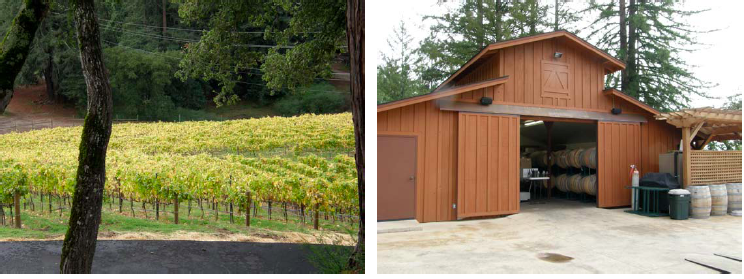
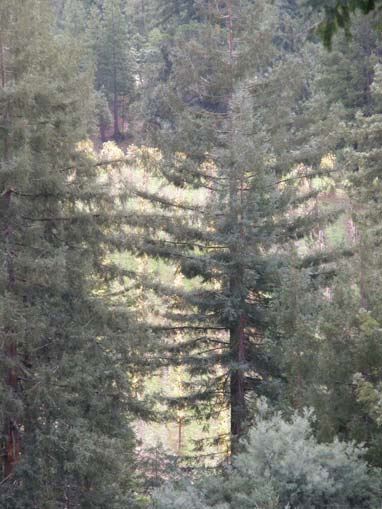 Robert’s son Brandon, has partnered with his father to produce the wines at Heart O’ The Mountain using the assistance of a consulting winemaker beginning in 2004. The first commercial release was in 2005 consisting of 180 cases of Pinot Noir. With the 2007 vintage there are three bottlings: an Estate blend consisting of all clones grown on the property, Estate Pommard Clone, and Estate Triple Seven (clone 777). The 2006 vintage of the Estate blend has been reviewed favorably by me previously, and at the time of my visit, the 2007 Estate blend had not been released. Current production is 800 cases.
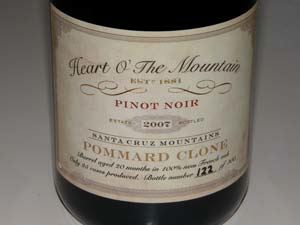 2007 Heart O’ The Mountain Estate Pommard Clone Santa Cruz Mountains Pinot Noir 14.6% alc., 25 cases, $48. Aged 20 months in 100% new French oak. 100% de-stemmed, whole berry fermentation. Unfined and unfiltered. Only available to Wine Club members. · Enticing and penetrating aromas of subtlety-spiced cherries which carry over to the flavor profile. Beautifully composed and harmonious with supple tannins and a clean, refreshing finish. Flat-out delicious with plenty of finesse to charm. One of the best Pinot Noirs tasted on this trip. Regretfully, it is already sold out to Allocation Club members. The Pommard clone thrives on this site.
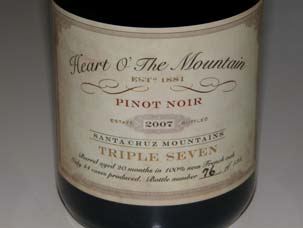 2007 Heart O’ The Mountain Estate Triple Seven Santa Cruz Mountains Pinot Noir 14.8% alc., 44 cases,$48. Whole berry fermentation after cold maceration. Aged 20 months in French oak. Unfined, unfiltered. · Deep color. Brooding nose showing ripe dark stone fruits, a hint of oak char and barnyard. Plenty of rich, plush and very ripe plum fruit fans out on the palate. The oak is a subtle accent, the texture is all velvet, and the finish lingers. A bold and aggressive wine that will appeal to lovers of hedonistic fruit. Very good.
Heart O’ The Mountain Pinot Noirs are sold almost exclusively to the winery’s Allocation Club members. Sign up at www.heartothemountain.com. The winery is not open to the public due to its relative inaccessibility created by a narrow one lane access road. Those who buy a case are invited to the annual winery party where they can tour the exterior of the historic Hitchcock house. 831-345-6133. The photo below shows Brandon (left) and his father Robert at the winery. The pair are extremely warm and gracious hosts.

Mount Eden VineyardsThis iconic Santa Cruz Mountains winery has been featured in the PinotFile in several issues. Among California wineries, Mount Eden’s lineage of estate bottled Pinot Noir and Chardonnay is the longest in California. Founded in 1945 by legendary vintner Martin Ray, it is recognized as one of the first “boutique” California winery properties with a unique focus on small lots of three varieties normally found in disparate locations: Pinot Noir, Chardonnay and Cabernet Sauvignon. Mount Eden Estate is situated at 2,000 feet overlooking Silicon Valley, reached by a winding 2.2-mile dirt road. The grape vines are planted in infertile Franciscan shale on a cool, exposed hilltop, leading to low-yielding, distinctive wines. Proprietor and winemaker, Jeffrey Patterson, has been at Mount Eden since 1981, a remarkable longevity for a California vintner. In 2007, Mount Eden acquired an additional 55 acres in the Saratoga foothills (the formerly Cinnabar Winery property), which has been named Domaine Eden. The Mount Eden Vineyards estate wines account for one-third of production. A Mount Eden Vineyards Saratoga Cuvée Pinot Noir and Chardonnay is produced from declassified estate grapes, grapes grown nearby, and Mount Eden’s satellite vineyard five miles to the south. Mount Eden Vineyards also produces nonestate Chardonnays from the central coast of California, primarily Edna Valley. Patterson consults on a number of winery projects including the recently revived Mountain Winery in Saratoga.
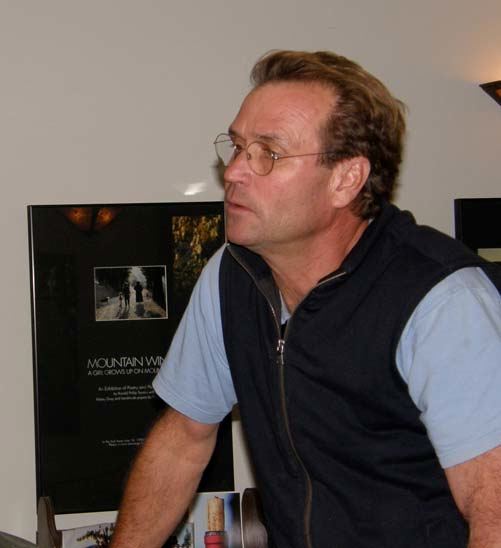 The Mount Eden site now consists of 40 acres of Chardonnay, Pinot Noir, and Cabernet Sauvignon, with small amounts of Merlot and Cabernet Franc. The Chardonnay and Pinot Noir were propagated from selections brought to California by French winemaker Paul Masson, while the Cabernet Sauvignon came from La Questa Vineyard in nearby Woodside. Patterson began a stepwise replanting of the vineyard at Mount Eden in 1984, but kept 1 acre of the original Pinot Noir vines as a “mother vineyard.” The remaining 6 acres of Pinot Noir are planted to Winery Lake, Mount Eden, Swan and Calera selections, and Dijon clones 115, 667, 777 and 828. The Mount Eden Estate Pinot Noir is a mosaic of all of these clones. Patterson is committed to dry farming, believing that with non irrigation the vintage character expresses itself more purely. Mount Eden Estate Chardonnay is grown on 20 acres, from which 1,200 to 2,000 cases are produced each year. The grapes are pressed without crushing and the juice is all barrel fermented in new and one year old French Burgundy barrels, where the wine undergoes full MLF and is aged on the lees for 10 months before being lightly filtered before bottling. The Chardonnay is then cellared for two years before being released for sale. Patterson aims for a longevity of 20 years for the Chardonnays and his past tastings of vintages that have aged this long, particularly in magnum format, have proved the capability of this site to produce remarkably age worthy wines. Pinot Noir vines occupy 7 acres of the Mount Eden estate vineyard and yields are typically one to one-and-a-half tons per acre. 50% to 100% whole cluster is used. Patterson kids about whole cluster saying, “The problem with whole cluster is the stems!” Natural yeasts are used for fermentation in small open-top fermenters, lasting 10 to 14 days with the must punched down by hand. The new wine is aged for 18 months in 75% new and 25% one-year-old French Burgundy barrels and bottled unfined and unfiltered. Patterson’s goal with Mount Eden Estate Pinot Noir is, “A wine that I am still proud of in 10 years.” The Pinot Noirs tend to be more austere upon release than many California examples, requiring several years of cellaring to reach their apogee (7 to 10 years). A 1998 Mount Eden Vineyards Estate Pinot Noir tasted at this year’s Pinot Days was superb with layers of flavor, impeccable balance, and charm to spare. The 2000 vintage was equally impressive.
2007 Mount Eden Vineyards Estate Santa Cruz Mountains Chardonnay 14.2% alc., 2,387 cases, $48. Fermented on wild yeast in 50% new and one-year-old French Burgundy oak barrels (Sirigue and Francois Freres) and aged 10 months with no movement whatsoever. Lightly filtered before bottling. · Clean aromas of pineapple, toast and lemon zest with delicate flavors of lemon curd, butter and herbs. Crisp and refreshing. Not as showy as the 2005 vintage, displaying more Burgundian austerity. Very good.
 2007 Mount Eden Vineyards Estate Santa Cruz Mountains Pinot Noir 13.8% alc., 668 cases, $48. A drought vintage (the worse since 1976). Despite the weather, the crop size was normal. Fermented on native yeasts with spontaneous MLF. Unfined and unfiltered. · More stacked and packed than usual for Mount Eden Pinot Noir, this wine has lovely scents of crushed plums and Morroccan spice followed on the palate with full-bodied black cherry and black plum flavors. There is deft use of oak, the acid spine is well proportioned, and the ripe, dry tannins caress the fruit, bringing the wine to a rich and powerful finish. Will continue to improve in the bottle. Very good and may eclipse the 2006 vintage over time.
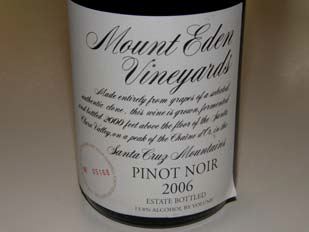 2006 Mount Eden Vineyards Estate Santa Cruz Mountains Pinot Noir 13.8% alc., $48. · I have tasted this wine numerous times and it has always been precocious and flashy. Bright and juicy earth and spicedusted black cherry fruit that sticks around in the mouth creating a long and lush impression on the finish. Absolutely delicious.
2005 Mount Eden Vineyards Estate Santa Cruz Mountains Chardonnay Table wine, 1,250 cases. A challenging year with poor fruit set. · Rich and toasty with more oak evident throughout. Concentrated citrus and mineral flavors accented by a prominent butteriness. More California in character. Very good.
2002 Mount Eden Vineyards Estate Santa Cruz Mountains Chardonnay Table wine. · Very slight yellowing. Aromas of brown butter and roasted nuts. Maturing nicely with flavors of white stone fruits and citrus and a clean finish. Decent (+).
2002 Mount Eden Vineyards Estate Santa Cruz Mountains Pinot Noir Table wine. · This wine veers to the austere side featuring lean aromas and flavors of cherries, berries, savory herbs, loam and green stems. Still sporting healthy tannins. Lacking charm at present and may be a slightly off bottle.
Mount Eden Vineyards Estate wines are sold through a mailing list, online and through retail distribution. Tasting is available at the Press Club in San Francisco (www.pressclubsf.com). Tours (without tasting) of the historic Mount Eden property are available each weekday by reservation (except during the harvest months of September and October). 408-867-5832, extension 10. Library wines are sold on the website (www.mounteden.com). The excellent 2006 Estate Pinot Noir is still available. Magnums of estate Pinot Noir and Chardonnay are also produced and highly sought after for their longevity
Small Sips of Santa Cruz Mountains Pinot Noir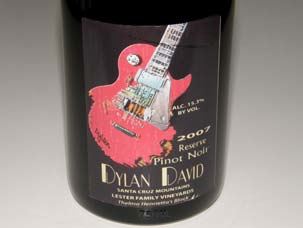 15.3% alc., $48. Clone 115, whole berry and whole cluster fermentation. Unfined and unfiltered. · Slightly confected dark red cherry and berry fruit aromas with a pleasing hint of oak and a touch of heat. Luscious in the mouth, finding every nook and cranny, and plush and softly textured. The tannins are reigned in and the oak nicely integrated letting the prodigious cherry and berry fruit shine. Very good, especially if you are a fan of this Caliesque style of Pinot Noir.
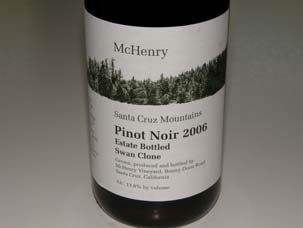 2006 McHenry Estate Bottled Swan Clone Santa Cruz Mountains Pinot Noir 13.8% alc., 158 cases, $25. Sourced from the estate vineyard planted to own-rooted cuttings from Swan Vineyard and Dijon clone 115. The vineyard is situated at 1,800 feet in the Ben Lomond sub-region of the Santa Cruz Mountains and is one of the closest vineyards to the Pacific Ocean in the AVA. · McHenry Pinot Noirs are very distinctive for their delicate aromas and flavors. Moderately light garnet color in the glass. Lovely aromas of cherries, strawberries, baking spices and a touch of oak. Moderately light in weight but delivering plenty of nuanced flavors of cherries, oak spice, crusty bread and a hint of raisin and earth. Soft in the mouth with gossamer tannins. Some might fine this style too dilute, but I find it quite charming. Very good and a great value as well.
 2006 David Bruce Santa Cruz Mountains Pinot Noir 14.5% alc., $44. · Ripe, dark fruits, straw, oak and a whiff of alcohol on the nose. Rich, generous and slightly sweet flavors of black cherries, plum and blackberries. Very smoothly textured with mild dry tannins and a brisk grip of acidity. Fine, but not exciting. Decent (+).
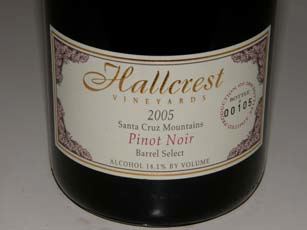 2005 Hallcrest Vineyards Barrel Select Santa Cruz Mountains Pinot Noir 14.1% alc., 233 cases, $42, Diam closure. A blend of grapes from the top five vineyards sourced by Hallcrest. · Ripe cherry and berry fruits, oak toast and vanillin on the attractive nose. Discreet but impressive depth and richness of flavor featuring darker ripe Pinot fruits, nicely spiced, flanked by harmonious t n ‘a. A well-crafted wine of great charm worthy of the Barrel Select designation. Very good.
2005 Hallcrest Vineyards Vista Del Mare Vineyard Santa Cruz Mountains Pinot Noir 14.5% alc., 167 cases, $42, Diam closure. This 4-acre vineyard is located in Scott’s Valley and looks out on Monterey Bay. · Ripe, slightly roasted fruit on the nose with added scents of black currants, maple syrup, exotic woods, Middle Eastern spices and a hint of alcohol. Black cherries are at the forefront on the attack with some attractive accents of spice and oak in the background. Soft in the mouth with fine-grain tannins and a slightly tart finish. Decent (+).
A.P. Vin: Plenty of Pinot SingingAndrew P. Vingiello was just another wine lover when he had his epiphany after drinking a Pinot Noir from the Santa Lucia Highlands of California. He began researching California Pinot Noir labels and was intrigued by Brian Loring who had entered the wine business cold from another profession. A telephone call to Loring led to one thing and another, and before long, Loring became Vingiello’s friend and mentor. Loring showed him the way, but many others offered information and inspiration including winemakers Adam Lee, Ed Kurtzman, and Peter Cargasacchi. A.P. Vin was launched with the 2003 vintage and now produces 2,000 cases of Pinot Noir annually. Vingiello has been fortunate to obtain grapes from some of California’s most prominent Pinot Noir vineyards. I can think of only a handful of other vintners with such an impressive lineup of vineyard sources. The name, A.P. Vin represents the history and heritage of the Italian Vingiello family name as well as containing “wine” in the name. Based in San Francisco, A.P. Vin has had a low profile. I haven’t seen the wines poured in recent years at World of Pinot Noir or Pinot Days. I have dabbled here and there in the past, trying an occasional A.P. Vin wine, but did not find anything remarkable. It was quite a surprise to me, then, to sample the latest 2007 vintage releases and find that these Pinot Noirs were all singing a catchy Pinot tune and were very well-crafted. They are vinified in the Kosta-Browne style and every bit as good. Of the four wines sampled, all of them were close to receiving a Pinot Geek confirmation. Befitting the sports season, I found the wines reflective of different positions on the football field. The wines are generally 100% de-stemmed and crushed. After fermentation and pressing, the new wine is placed in a variety of new and old French oak barrels for 11 months of aging.
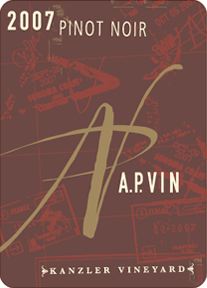 2007 A.P. Vin Kanzler Vineyard Sonoma Coast Pinot Noir 15.2% alc., 250 cases, $40, Stelvin screw cap. Clones 667 (10% whole cluster) and Pommard. Aged 11 months in 50% new French oak. Unfined and unfiltered. · Intriguing aromas of black fruits, Moroccan spices, cedar, earth and brier patch. The least forthcoming wine in the lineup with copious and brooding dark fruit. Begins to open with time in the glass revealing an intense plum fruit finish. Little nuance now, but has amazing fruit and will get much better over time. The fullback in the lineup: muscular, hard headed, imposing. Very good (+).
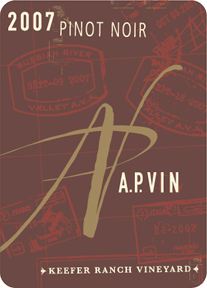 2007 A.P. Vin Keefer Ranch Vineyard Russian River Valley Pinot Noir 14.7% alc., 250 cases, $40, Stelvin screw cap. Clones 777, Pommard 4, 2A and 23. Aged 11 months in 50% new French oak. Unfined and unfiltered. · Redder fruits that are pure and bright with a touch of herbs and baking spices on the nose. Intense cherry and raspberry core with noticeable persistence on the finish marked by a touch of citrus tang. Well-proportioned with perfect balance. The tailback in the lineup: not the biggest player, but flashy, in control and wellsculpted. Very good (+).
 2007 A.P. Vin Rosella’s Vineyard Santa Lucia Highlands Pinot Noir. 14.9% alc., 375 cases, $40, Stelvin screw cap. Clones 777, 115 and Pisoni. Aged 11 months in 40% new French oak. Unfined and unfiltered. · Enticing scents of perfectly ripe cherries and berries with side car notes of oak and spice. A cherry bombast in the mouth that literally explodes on entry, well-clothed in ripe tannins and bright acidity. The aromatic finish lasts and lasts. A seamless wine with the most finesse of all the wines in this lineup. Fantastic the next day from a previously opened and re-corked bottle. The quarterback in the lineup: good-looking, clean, smart and demands the focus of attention.
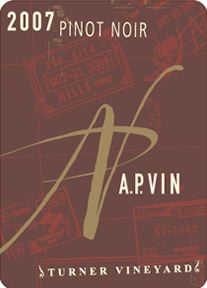 2007 A.P. Vin Turner Vineyard Santa Rita Hills Pinot Noir 14.8% alc., 125 cases, $55, Stelvin screw cap. Clones 667 (10% whole cluster), 114 and 777 (5% whole cluster). Aged 11 months in 50% new French oak. Unfined and unfiltered. · Very dark reddish-purple in the glass. Wooded dark fruit, spiced plum and smoke on the nose. Very taste core of dark berries, black cherries, and plums with an earthy undertone. Flashy and juicy with well-endowed fine-grain dry tannins. Showing admirable silkiness and elegance on the palate, this wine grew on me, and the more I sampled it, the more I liked it. This is the linebacker in the lineup: husky, down and dirty, but deft and agile on its feet. Very good (+).
A.P. Vin wines are sold through a mailing list at www.apvin.com and through retail distribution. Besides the above wines, there is a Clos Pepe Vineyard Pinot Noir and Garys’ Vineyard Pinot Noir for 2007. For 2008, the Ridgetop Vineyard (Sonoma Coast) and Rancho Ontiveros Vineyard (Santa Maria Valley) are new additions. The 2008 vintage Pinot Noirs have already shipped. Phone 415-218-7161 to inquire about tasting.
Eldridge Estate (Yes, there is great Pinot Noir in Oz)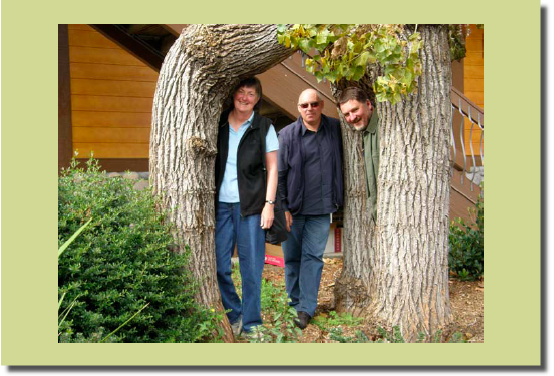 My recent trip to the Santa Cruz Mountains was made extra special by the three winos from Down Under pictured above (Wendy and David Lloyd with Peter Brown in the center). The Lloyds own a boutique winery in the Red Hill region of the Mornington Peninsula in southeastern Victoria, Australia and specialize in Pinot Noir. I visited them last year on my trip to Australia, and discovered their special wines. David had read a feature I wrote on the Santa Cruz Mountains and noticed a number of similarities between the Santa Cruz Mountains and the Mornington Peninsula. A trip was planned and well-taken recently. The Lloyds farm an estate vineyard of 7 acres planted to Pinot Noir, Chardonnay, Gamay and Sauvignon Blanc. In location, the site is very similar to Burgundy in France but in the opposite hemisphere. The soil is a rich volcanic loam and a spring-fed dam on the property allows for necessary irrigation. The site is protected by natural land forms resulting in a long, cool growing season. The vines are trained using the Scott Henry system of canopy management developed in the 1980s at the Scott Henry Vineyard in Oregon. Six clones of Pinot Noir are planted including Dijon 114, 115, 777, 2A, Pommard and MV6 (“Mother Clone”). Eldridge Estate wines have received considerable acclaim in Australia, and in the 2010 James Halliday Wine Companion, Eldridge Estate was listed as a Five Star Winery. Unfortunately, the wines, like many fine Pinot Noirs from the Mornington Peninsula, are snapped up by locals who visit the cellar doors (tasting rooms) and are not exported to the United States. I have had the good fortune to sample the Eldredge Estate Pinot Noirs both here and in Australia and have been very impressed by the elegant style of the wines which are modeled after those of Chambolle-Musingy. I sampled a few vintages of Eldridge Estate Pinot Noir that David brought with him from Australia to the Santa Cruz Mountains. The 1999 vintage was spectacular, still filled with enticing, fresh fruit and charm. The wine reviewed below was sampled at home after the trip. Visit the website at www.eldridge-estate.com.au.
 2006 Eldridge Estate Red Hill Mornington Peninsula Victoria Australia Pinot Noir 14.0% alc., screw cap. · Moderate deep red color in the glass. Attractive aromas of cherries and ripe strawberries with a hint of oak and mint. Delicious slightly confected cherry core that is rich yet light on its feet. Accents of savory herbs and cinnamon spice are complimentary. Beautifully composed with gossamer tannins and a crisp finish. My only nit would be a lack of persistence on the refreshing finish but the wine more than makes up for this with upfront charm.
|